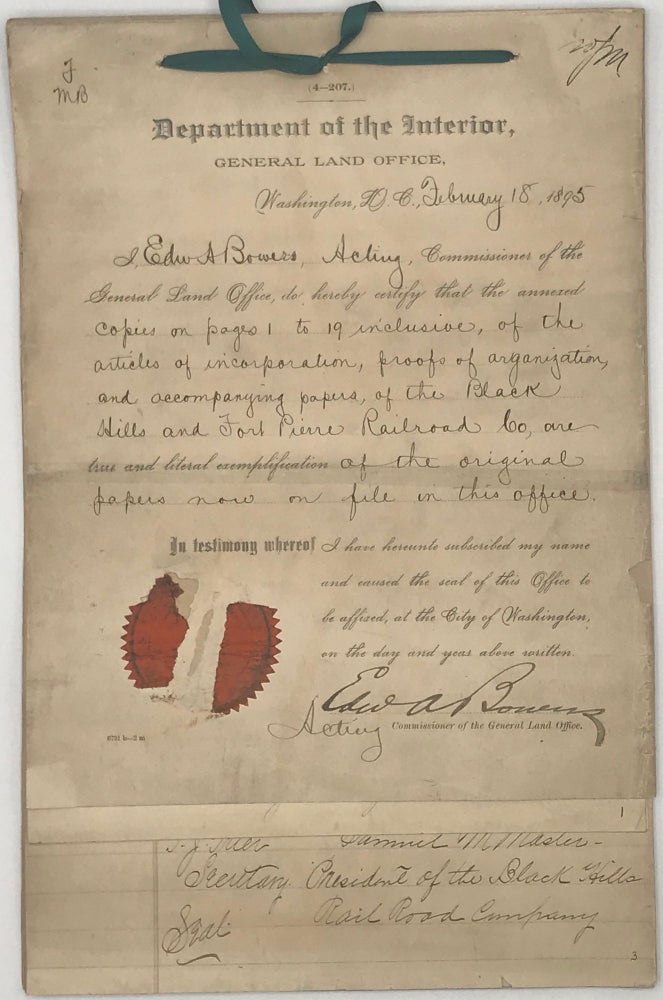
ARTICLES OF INCORPORATION, PROOFS OF ORGANIZATION, AND ACCOMPANYING PAPERS FOR THE BLACK HILLS AND FORT PIERRE RAILROAD COMPANY, 1881-82, 1895.
[Lead City, Dakota Territory: 1881-82, 1895]. Copies, in a neat clerical hand, of the articles of incorporation and other supporting papers for the Black Hills and Fort Pierre Railroad Company. 4to & 8vo, bound with ribbon along the top page margins, 19 pp. on yellow lined paper, plus a cover sheet on letterhead from the Department of Interior, General Land Office, Washington, D.C., dated February 18, 1895, with the signature of Acting Commissioner of the Land Office Edw. A. Bowers, and the seal of the office (partly chipped away), certifying the copies as "true and literal exemplification[s]" of the originals. The first document is a letter from H.M. Teller, Secretary, Dept. of the Interior, Washington, Oct. 7, 1882, acknowledging the railroad's change of name from the Black Hills Railroad Company, originally incorporated in 1881, to the Black Hills and Fort Pierre Railroad Company in 1882. The principal place of business for the corporation was to be in Lead City. The operation's intent was "the transportation of freight and passengers" with a route beginning in Deadwood, by way of Central City and Lead City in Lawrence County, to Custer City in the County of Custer, with a branch to Rapid City in Pennington County, some 60 miles of rails. The remainder of the papers include the company's Certificate of Incorporation, along with eight articles, a list of the officers, the owners, the number of shares per owner, and testimony from George Kingsbury, one of the printers and publishers of the Daily Press & Dakotaian newspaper, that the notice of a name change was published in their paper for three successive weeks.
Samuel McMaster of Lead City, Dakota Territory was President and part owner of the railroad company. He along with two other Lead City residents, Thomas James and Thomas J. Grier, each owned 5 shares of stock with a par value of $100 each. The balance of the company, with a capital stock of $500,000 belonged to two San Francisco businessmen, George Hearst and James B. Haggin. They each owned 2492.5 shares. Item #66125
The Dakota Territories experienced a boom in growth in the 1860s and 1870s. Many settlers arrived to take advantage of the Homestead Act of 1862, and gold was discovered in the Black Hills in the 1870s. The need for good, reliable transportation continued to grow as the Territory grew. George Hearst and James Haggin, business partners in San Francisco with investments in mines and horses, purchased the Homestake Mine, near Bobtail Gulch in the Black Hills in 1877. It would eventually become the largest gold mine in the country. They built the Black Hills and Fort Pierre Railroad to more efficiently transport needed the timber, equipment and supplies to the mine, and they founded a company store in the town of Lead to supply the miners and the growing town. [see: Steven Kinsella's article, "Company Store: The Hearst Mercantile, 1879-1942," (South Dakota State Historical Society: 1990)].
No listings found on OCLC.
Price: $1,750.00
